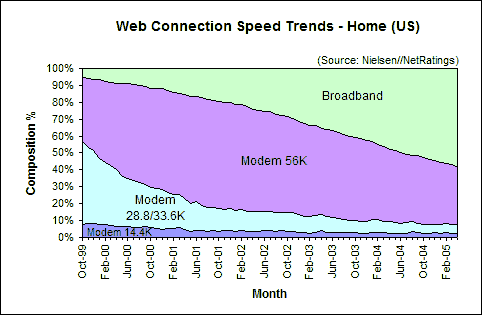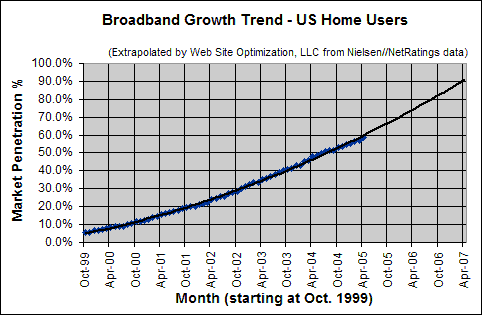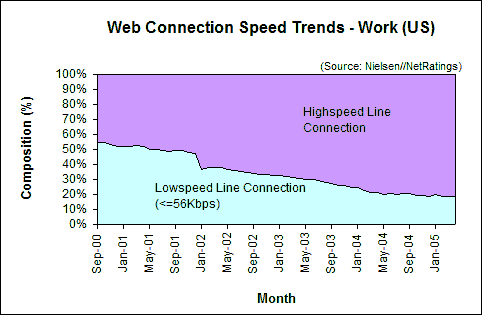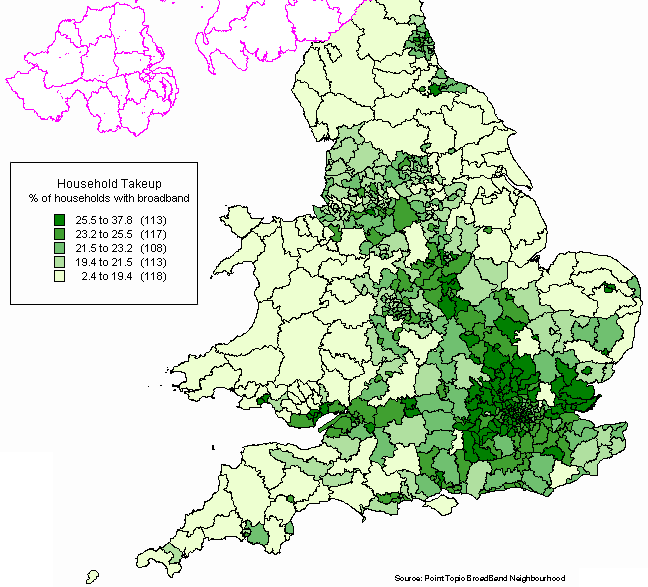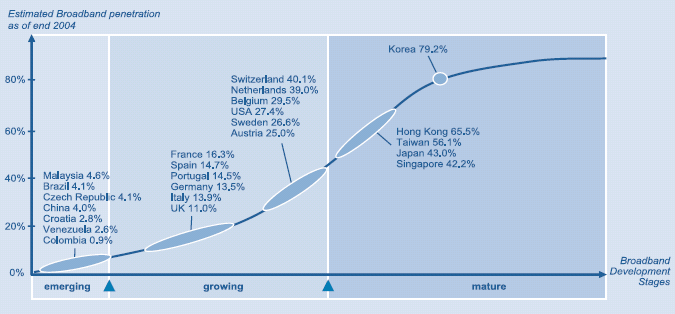In Britain, broadband penetration is a tale of haves and have-nots. Just as we found in Europe, relatively young and affluent areas have higher broadband penetration rates than older, less affluent constituencies. Does Labour beat the Tory party in the race for broadband supremacy? In April, U.S. broadband penetration jumped by 1.42 percentage points to 58.46% among active Internet users. At its recent growth rate, broadband penetration in the U.S. should break 60% by July 2005 at the latest.
The charts below, derived from Nielsen//NetRatings and Point Topic data, show trends in connection speeds to the Internet for United States and United Kingdom users.*
Home Connectivity in the US
Most active Internet users connect from home with broadband connections. Among narrowband users, 33.9% use 56Kbps modems, 5.12% use 28/33.3Kbps, and 2.52% use 14.4Kbps modems. In total, 41.54% of home users in the US connect to the Internet at 56Kbps or less (see Figure 1).
Web Connection Speed Trends – Home Users (US)
Figure 1: Web Connection Speed Trends – Home Users (US)
Source: Nielsen//NetRatings
Broadband Growth in the US
Broadband penetration in the US grew by 1.42 points to 58.46% in April, up from 57.04% in March. This increase is well above the average increase in broadband of 0.92 points per month over the previous twelve months. At the current growth rate, broadband penetration among active Internet users in the US should break 60% by mid-summer 2005 (see Figure 2).
Broadband Connection Speed Trend – Home Users (US)
Figure 2: Broadband Connection Speed Trend – Home Users (US)
Extrapolated from Nielsen//NetRatings data
Work Connectivity
Most workers in the US enjoy high-speed connections to the Internet. Most use a high-speed line such as a T1 connection, and share bandwidth between computers connected to an Ethernet network. The speed of each connection decreases as more employees hook up to the LAN. As of April of 2005, of those connected to the Internet, 81.33% of US users at work enjoy a high-speed connection, down 0.2 percentage points from the 81.53% share in March. At work, 18.67% connect at 56Kbps or less (see Figure 3).
Web Connection Speed Trends – Work Users (US)
Figure 3: Web Connection Speed Trends – Work Users (US)
Source: Nielsen//NetRatings
UK’s Digital Divide
Point Topic’s founder Tim Johnson has an interesting article that maps the “digital divide” in the UK. Plotting broadband takeup over political constituencies, the maps show that relatively young and affluent areas have higher broadband penetration rates than older and less affluent constituencies (see Figure 4). UK’s broadband penetration has a similar trend to Europe’s Digital Divide. Seven out of the top 10 most broadband constituencies are Labour, while the more rural Wales accounts for seven of the ten least broadband constituencies in southern Britain.
Figure 4: UK Broadband Penetration by Constituency
Source: Point Topic (used with permission)
The Stages of Broadband Development by Country
From AD Little’s latest “Broadband Update 2005” report comes a graph showing the three development stages of broadband, emerging, growing, and mature (see Figure 5). The Pacific Rim is firmly in the lead in the mature phase with Korea leading the way at 79.2% penetration, while European countries and the US fall into the growing phase, and countries like Malaysia, Brazil, and Columbia fall into the emerging phase of broadband development.
Figure 5: Broadband Development Stages (end of 2004)
Source: Arthur D. Little (used with permission)
Further Reading
- Almost Three-Quarters of All U.S. Adults – An Estimated 163 million – Go Online
- Over 54% of adults who go online use broadband at home says Harris Interactive. In a telephone poll of 2,022 U.S. adults Harris found that 74% are now online, up from 73% in the summer of 2004.
- Broadband, the Internet and the Election – Mapping the “Digital Divide”
- After the UK election, Point Topic provided a series of maps showing the “digital divide” in Britain, with broadband takeup plotted over political constituencies in England and Wales. The maps show that relatively young and prosperous constituencies had the highest broadband penetration (upwards of 37% in Cardiff) while Wales had the lowest broadband penetration rates. Point Topic, April 21, 2005.
- Global Broadband Broadband Report Update 2005 (PDF)
- Arthur D. Little’s in-depth report on broadband includes a graph showing the different stages of broadband penetration in various countries, with Korea leading the way.
- Nielsen//NetRatings
- Provides the US broadband data (percentage of active Internet users) for the Bandwidth Report.
*Note that Nielsen//NetRatings reports the percentage of active Internet users that use broadband from home, not broadband households. NetRatings uses a panel of 40,000 to 50,000 people with software meters installed on their computers. These meters detect connection speeds. Each month they do an enumeration study to call a number of people to calibrate the panel by adjusting weightings to match the population at large.
The Bandwidth Report is featured monthly on URLwire – news of useful and unique web content since 1994.

